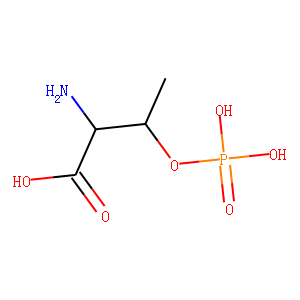| Reference | [1]. Acta Crystallogr C. 1996 Jul 15;52 ( Pt 7):1736-41. doi: 10.1107/s0108270195015708.<br />
O-phospho-DL-threonine and O-phospho-L-threonine compared with their serine analogs.<br />
Maniukiewicz W(1), Kwiatkowski W, Blessing RH.<br />
Author information: (1)Hauptman-Woodward Institute, Buffalo, New York 14203, USA.<br />
In crystals of O-phospho-DL-threonine and O-phospho-L-threonine, the molecules are zwitterions HO3-POCH-(CH3)CH(NH3+)CO2H linked by three-dimensional networks of strong P-O-H…O = P, C-O-H…O = P, N-H…O = P and N-H…O = C hydrogen bonds with (O…O) = 2.55 (3) A and (N…O) = 2.84 (4) A. Both the molecular conformations and the nearest-neighbor hydrogen-bonded surroundings are very similar in the racemic and enantiomeric crystals of the threonine compounds, but earlier studies of crystals of the analogous serine compounds have shown that the serine zwitterions HO3-POCH2CH(NH3+)CO2H have different conformations about the C beta-O gamma-P phosphate ester bonds and different hydrogen-bonded surroundings.<br />
DOI: 10.1107/s0108270195015708 PMID: 8756262 [Indexed for MEDLINE]<br />
<br />
[2]. Macromol Biosci. 2008 Jan 9;8(1):46-59. doi: 10.1002/mabi.200700096.<br />
Fibrous and helical calcite crystals induced by synthetic polypeptides containing o-phospho-L-serine and o-phospho-L-threonine.<br />
Hayashi S(1), Ohkawa K, Suwa Y, Sugawara T, Asami T, Yamamoto H.<br />
Author information: (1)Institute of High Polymer Research, Faculty of Textile Science and Technology, Shinshu University, Ueda 386-8567, Nagano Prefecture, Japan. [email protected]<br />
The modification of CaCO(3) crystal growth by synthetic L-Ser(PO(3)H(2)) and L-Thr(PO(3)H(2)) containing polypeptides is described. The amino acids Gly, L-Glu, L-Asp, L-Ser, L-Ala, and L-Lys induced rhombohedral calcite with a rough surface. Dipeptides, Xaa-L-Ser(PO(3)H(2)) (Xaa = Gly, L-Glu, L-Asp, L-Ser, L-Ala and L-Lys) induced vaterite crystals in the lower [Ca(2+)]. On the other hand, L-Ser(PO(3)H(2))-containing polypeptides formed spherical vaterite and fibrous calcite. The characteristic helical calcite was found in the presence of copoly[L-Ser(PO(3)H(2))(75)L-Asp(25)] or poly[L-Ser(PO(3)H(2))(3)-L-Asp]. Fibrous calcite, spherical vaterite, and helical calcite crystals were subjected to XRD and EDX analysis. XRD revealed the specific faces of these crystals. EDX spectra and surface analysis visualized the localization of the polypeptides and CaCO(3) components. Together with TEM and SAED data, we propose hypothetical growth mechanisms for the fibrous and helical calcite crystals.<br />
DOI: 10.1002/mabi.200700096 PMID: 17902188<br />
<br />
[3]. Macromol Biosci. 2006 Mar 14;6(3):228-40. doi: 10.1002/mabi.200500211.<br />
Random and sequential copolypeptides containing O-phospho-L-threonine and L-aspartic acid; roles in CaCO3 biomineralization.<br />
Hayashi S(1), Ohkawa K, Yamamoto H.<br />
Author information: (1)Institute of High Polymer Research, Faculty of Textile Science and Technology, Shinshu University, Tokida 3-15-1, Ueda 386-8567, Japan.<br />
The present study describes the synthesis of novel polypeptides containing O-phospho-L-threonine [Thr(PO(3)H(2))] and L-aspartic acid. Random copolypeptides copoly[Thr(PO(3)H(2))(X)Asp(Y)] (X:Y = 25:75, 50:50, 75:25), were conventionally prepared by copolymerization of Thr(PO(3)Ph(2)) N-carboxyanhydride (NCA) and Asp(OBzl) NCA followed by deprotection of the phenyl and benzyl groups by catalytic hydrogenolysis over PtO(2). Polycondensation of the protected peptide p-nitrophenyl esters [Thr(PO(3)Ph(2))](Z)-Asp(OBzl)-ONp and subsequent deprotection yielded the sequential polypeptides poly[Thr(PO(3)H(2))(Z)-Asp] (Z = 1-4). By using the synthetic polypeptides, their effects on the growth of CaCO(3) crystals were examined. In the poly[Thr(PO(3)H(2))(Z)-Asp]/CaCO(3) systems, brushlike calcite and spherical vaterite were formed, with the former being found at [Ca(2+)]/[Res] ratios of > or =180, > or =140, > or =120, and > or =100 for Z = 1, 2, 3, and 4, respectively. These results indicate that an increase of Thr(PO(3)H(2)) residues in the repetitive unit induces the characteristic brushlike calcite, a fact indicating that Thr(PO(3)H(2)) residues can modify the CaCO(3) crystal morphology.<br />
DOI: 10.1002/mabi.200500211 PMID: 16534760<br />
<br />
[4]. FEBS Lett. 1987 Aug 17;220(2):358-62. doi: 10.1016/0014-5793(87)80846-3.<br />
On the role of N-7-mercaptoheptanoyl-O-phospho-L-threonine (component B) in the enzymatic reduction of methyl-coenzyme M to methane.<br />
Ellermann J, Kobelt A, Pfaltz A, Thauer RK.<br />
The reduction of methyl-coenzyme M (CH3SCoM) to methane in methanogenic bacteria is dependent on component B (N-7-mercaptoheptanoyl-O-phospho-L-threonine, HSHTP). We report here that S-methyl-component B (N-7-(methylthio)heptanoyl-O-phospho-L-threonine, CH3SHTP) can substitute for neither CH3SCoM nor HSHTP in the methyl-CoM reductase reaction. Rather, CH3SHTP proved to be an inhibitor competitive with HSHTP (apparent Ki = 6 microM) and noncompetitive with CH3SCoM. These results make it very unlikely that HSHTP functions as a methyl group carrier. A role for HSHTP as direct electron donor for CH3SCoM reduction to CH4 is proposed.<br />
DOI: 10.1016/0014-5793(87)80846-3 PMID: 3111890<br />
<br />
[5]. Dalton Trans. 2018 Jul 14;47(26):8595-8604. doi: 10.1039/c8dt00241j. Epub 2018 Apr 25.<br />
Facile preparation of multifunctionalisable 'stealth' upconverting nanoparticles for biomedical applications.<br />
Nsubuga A (1), Sgarzi M , Zarschler K , Kubeil M , Hübner R , Steudtner R , Graham B , Joshi T , Stephan H .<br />
Author information: (1)Institute of Radiopharmaceutical Cancer Research, Helmholtz-Zentrum Dresden-Rossendorf, Bautzner Landstraße 400, 01328 Dresden, Germany. [email protected] [email protected] [email protected].<br />
Pure hexagonal (β-phase) NaYF4-based hydrophobic upconverting nanoparticles (UCNPs) were surface-modified with O-phospho-l-threonine (OPLT), alendronic acid, and PEG-phosphate ligands to generate water-dispersible UCNPs. Fourier-transform infrared (FTIR) spectroscopy was used to establish the presence of the ligands on the UCNP surface. These UCNPs exhibit great colloidal stability and a near-neutral surface at physiological pH, as confirmed by dynamic light scattering (DLS) and zeta potential (ζ) measurements, respectively. The particles also display excellent long-term stability, with no major adverse effect on the size of UCNPs when kept at pH 7.4. Upon exposure to human serum, PEG-phosphate- and alendronate-coated UCNPs showed no formation of biomolecular corona, as confirmed by SDS-PAGE analysis. The photophysical properties of water-dispersible UCNPs were investigated using steady-state as well as time-resolved luminescence spectroscopy, under excitation at ca. 800 nm. The results clearly show that the UCNPs demonstrate bright upconversion (UC) luminescence. Furthermore, the presence of reactive groups on the NPs, such as free amine groups in alendronate-coated UCNPs, enables further functionalisation of UCNPs with, for example, small molecules, peptides, proteins, and antibodies. Overall these protein corona resistant UCNPs show great biocompatibility and are worthy of further investigation as potential new biomaging probes.<br />
DOI: 10.1039/c8dt00241j PMID: 29691531
|

